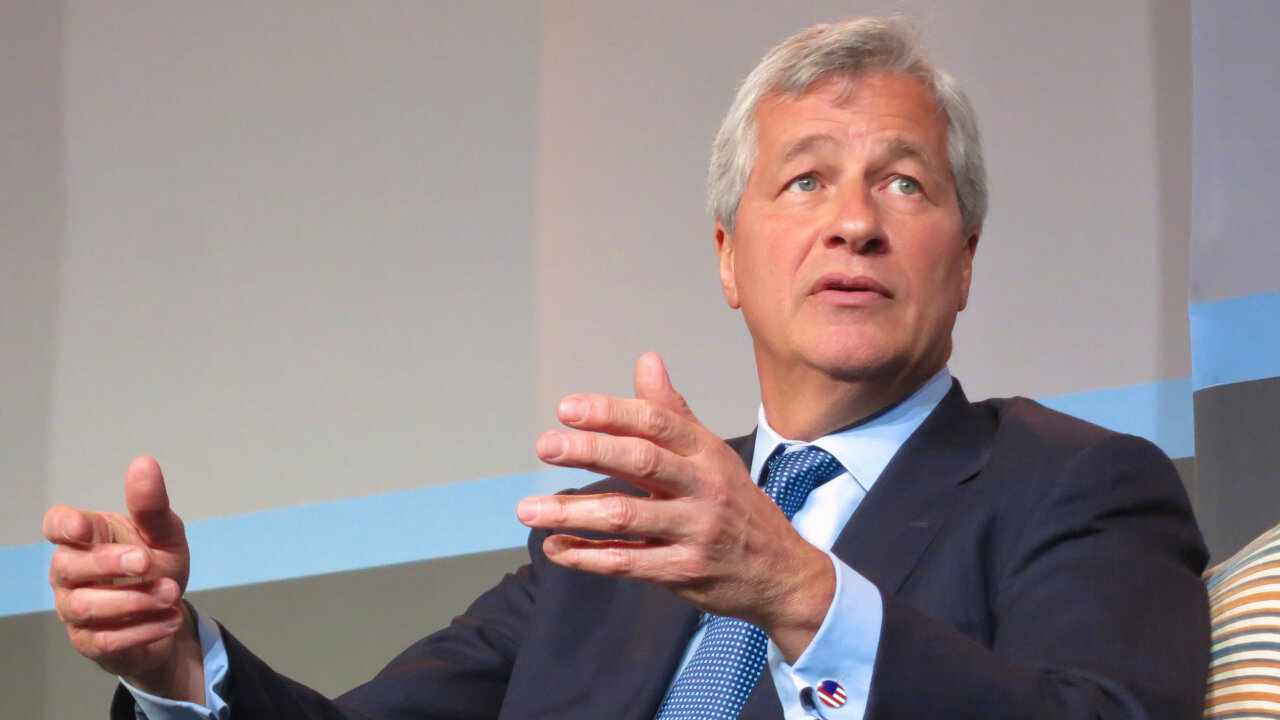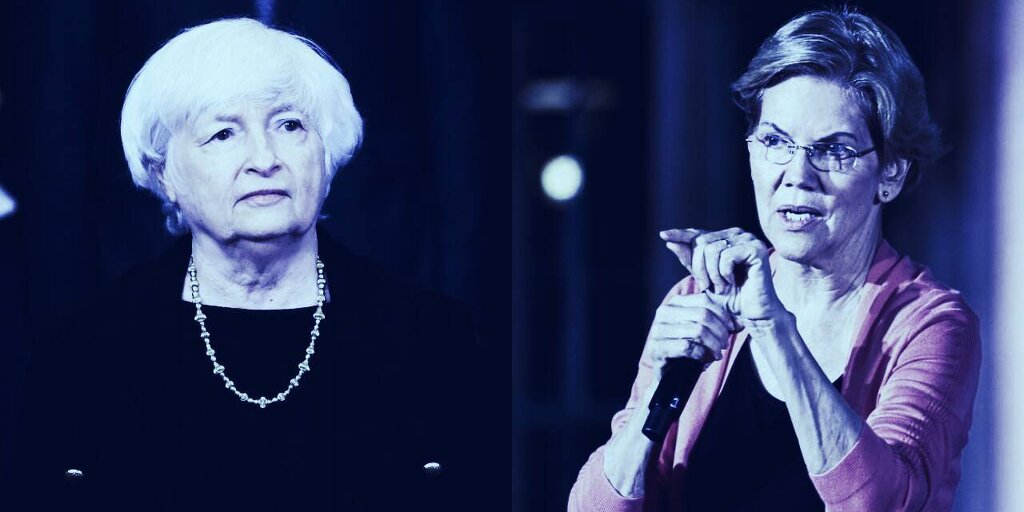In brief
The Biden Administration’s crypto strategy hinges on stablecoins.
The strategy is to use federal agencies to squeeze stablecoin issuers.
The ultimate beneficiary is likely to be the big banks.
“Just because you’re paranoid doesn’t mean they aren’t after you.” That adage has been attributed to everyone from Henry Kissinger to Kurt Cobain, but these days it would be a fitting motto for the crypto industry.
In 2021, crypto believers became convinced that the U.S. government has it in for them. And not without reason: a series of decisions by the SEC and other regulators suggested that federal officials are not just indifferent to the industry, but actively hostile to it.
The question is why. While many crypto advocates insist the government is corrupt or inept, the reality is that the Biden Administration is pursuing a crafty strategy to tame an industry it views as a threat.
Interviews with former regulators and executives at top crypto firms reveal a sophisticated plan not to crush crypto, but to co-opt it by handing a core part of the crypto industry—stablecoins—to the big banks. Doing this, regulators believe, will bring the free-wheeling crypto economy to heel.
“It’s a very thought-through doctrine about how to stop the crypto industry from growing too fast and too much,” says Maya Zehavi, a crypto entrepreneur and investor who has advised regulators.
Who exactly is behind the strategy? While many view the ambitious SEC Chair Gary Gensler as the architect of the Biden Administration’s anti-crypto policies, his influence has been overstated. It is instead Treasury Secretary Janet Yellen, Senator Elizabeth Warren, and a clique of Federal Reserve veterans who appear to be calling the shots.
According to Zehavi and others, the Biden Administration doesn’t want to kill stablecoins altogether. Instead, the aim is to cull what these lawmakers perceive as “shadowy” operations like Tether while bringing “regulator-friendly” ones like Circle and Paxos under the umbrella of the U.S. banking system.
Recent actions by regulators suggest the plan is already underway. The question now is whether the crypto industry can avoid being owned by the same big banks it set out to disrupt.
Stablecoins: The key to taming crypto
Bitcoin was born in 2008, but it would take more than a decade for the U.S. government to take crypto seriously. When it finally did, it was because of stablecoins.
According to Jerry Brito, executive director of the non-profit Coin Center, Facebook’s announcement in 2019 that it would launch its own digital currency was a watershed moment. The company said the currency, originally called Libra, would be a stablecoin pegged to a basket of government-issued currencies.
Facebook was hardly the first to hit on the idea of a stablecoin. As early as 2014, crypto users have relied on digital tokens pegged to so-called fiat currencies like the U.S. dollar or the euro. But when Facebook announced it would offer a stablecoin to its more than 2 billion users, Congress snapped to attention. The company’s crypto ambitions represented not just a new product but a challenge to governments’ power over the purse. As crypto lawyer Preston Byrne wrote at the time, “If Facebook raised an army, this would be only slightly more hostile to the people of the United States.”
While stablecoins have yet to enter the mainstream, they have become a critical part of the crypto industry. Tokens like Tether’s USDT and Circle’s USDC provide a shelter from volatility, while also letting traders avoid the fees that typically come with moving money back to traditional currency. And it doesn’t hurt that stablecoins make it easier to avoid the tax and legal regimes that kick in whenever a customer touches so-called “fiat rails” where traditional banks operate.
All of this comes as the U.S. Treasury has grown sensitive to challenges to its sovereignty, including efforts by geopolitical rivals Russia and China to weaken the dollar’s role as the world’s reserve currency. While China has promoted its digital yuan as one alternative, America’s antagonists would be equally pleased if Bitcoin or another cryptocurrency replaced the dollar in global commerce. These geopolitical considerations help explain the blowback to Facebook’s Libra project (and to crypto writ large).
Political backlash all but neutered Libra, but the broader stablecoin market is still flourishing. Today its market cap sits around $155 billion while trades involving stablecoins account for more than 70% of all crypto transactions on any given day. And this could be just the beginning. Circle, the second-largest issuer of stablecoins, told its investors in July that the value of USDC in circulation could reach $194 billion by 2023—an amount that matches the GDP of Greece.
Circle, which is allied with crypto giant Coinbase, has long touted its efforts to stay on the right side of regulators—even as the company has been entangled in an SEC investigation and controversies over its reserves. Tether has been dogged by more serious allegations related to sketchy accounting practices, and questions of whether some stablecoins are actually backed by dollars at all. The company has already been fined $41 million by the CFTC and $18.5 million by the state of New York, and is the subject of multiple federal investigations over what exactly backs its stablecoin.
All of this has led stablecoins to become the prime target in the federal government’s belated attempt to oversee the crypto markets. The response has included a January report from the Federal Reserve that discussed the potential for a central bank digital currency, but concluded the Fed would not act without a clear mandate from Congress and the White House.
Far more significant was a report published in November by the President’s Working Group, an inter-agency group of the country’s most senior financial regulators, including Yellen. Titled “Report on Stablecoins,” the document called on Congress to pass laws requiring stablecoin issuers to operate as banks and to restrict their “affiliation with commercial entities.”
The report also stated that regulators may take the step of labeling stablecoin issuers as “systemically important,” a designation created in the wake of the 2008 financial crisis to oversee institutions that, in the parlance of those times, are “too big to fail.”
Few people think the report’s authors are serious about treating stablecoins as too big to fail. Unlike the massive insurer AIG, which fell into that category, stablecoins are not interwoven with the rest of the U.S. financial system.
Tether, USDC, and Binance all offer stablecoins for the crypto industry. Image: Shutterstock
Steven Kelly, a researcher at the Yale Program on Financial Stability, points out that the $155 billion stablecoin economy is a drop in the bucket compared to money market funds, which are today worth nearly $5 trillion and have been a catalyst of past financial crises.
In this light, claims that stablecoins pose an existential threat to the financial system look flimsy. Nonetheless, there is little doubt U.S. regulators view crypto as a threat to the financial status quo, and believe stablecoins are the key to stopping it.
Zehavi says the Biden Administration’s strategy is to choke the stablecoin market through regulation; the government believes this can yield new opportunities for tax collection and also slow the growth of the broader crypto market. That’s because stablecoins are the tool crypto traders use to move in and out of positions—new restrictions on stablecoins are therefore likely to create friction for traders, and make trading other forms of crypto inconvenient or expensive.
“Give it to the banks”
U.S. regulators can lay down the law, but they are constrained by law themselves. What they want to do is not always the same as what they can do.
This is especially the case for Gensler, who is rumored to be seeking the job of Treasury Secretary. When it comes to regulating stablecoins, the SEC chairman is more like the Wizard of Oz (appropriately enough, a political allegory about control of the U.S. money supply) than an all-powerful policeman.
According to many legal observers, the SEC does not have clear jurisdiction over stablecoins since they are not securities. Unlike shares of stock (or most cryptocurrencies for that matter), people do not acquire stablecoins in the hopes of making a profit—one of the key factors in the SEC’s favored “Howey Test” for determining whether something is an investment contract. Since the value of stablecoins stays constant, it’s hard to make a case that they are an investment.
According to Brito of Coin Center, the legal status of stablecoins is more akin to the money used in PayPal or Venmo transactions. In such transactions, customers don’t send actual dollars to each other but rely on companies to debit or credit their accounts using internal funds. A dollar sent via Venmo, or a stablecoin, serves as money, but that doesn’t mean it’s treated as an investment overseen by the SEC.
The question of who does get to regulate stablecoins came up in the President’s Working Group report published in November. The report, which will be the subject of a February 8 Congressional hearing, notes the SEC has claimed stablecoins could be classified as securities, but it adds that another agency—the Federal Reserve—views stablecoins as bank deposits that fall under its jurisdiction.
And according to experts like Josh Mitts, a securities law professor at Columbia University, the Fed has more political juice than the SEC. “If push comes to shove, the Fed will win,” says Mitts.
Indeed, it appears the Fed has already won. A source familiar with the drafting of the stablecoin report says Gensler pushed for it to include language granting clear jurisdiction to the SEC, but the Treasury Department rebuffed him.
Instead, the Biden Administration intends to exert control over the stablecoin market—and potentially the broader crypto industry—through the Fed and two of its sister banking agencies: the Office of the Comptroller of the Currency (OCC) and the Federal Insurance Deposit Corporation (FDIC), both of which have immense authority over the country’s banks.
“There are many ways these banking regulators can strangle crypto if they force all these requirements from the traditional banking space into the crypto space,” says Mary Beth Buchanan, a former U.S. Attorney who is now the top lawyer for crypto forensic firm Merkle Science.
Early evidence of the Fed’s putting the screws to crypto includes its treatment of Kraken and Avanti, two crypto companies that have obtained state banking charters in Wyoming. The firms applied more than a year ago to receive a so-called master account at the central bank—essential for federal banking operations—but the Fed has so far refused to process them. Fed Chair Jay Powell recently justified the delay on the grounds that the Wyoming firms’ applications are “novel” and “precedential.” Wyoming Senator Cynthia Lummis has countered that the agency’s slow-rolling is harmful and illegal.
Meanwhile, the OCC has rebuffed applications from other crypto companies to receive federal banking charters that would entitle them to obtain FDIC insurance—ensuring that traditional financial institutions, not crypto ones, are the only ones that can engage in day-to-day banking.
The upshot is that the banking regulators are poised to achieve what they want—forcing stablecoins into the traditional banking regime—but without giving crypto companies a seat at the table.
“They’re going to just hand this to the big banks,” says one former Wall Street executive who now leads a crypto company. “It’s a total snow job by JP Morgan.”
 Jaime Dimon is the CEO of JP Morgan. Image: Wikipedia/Creative Commons
Jaime Dimon is the CEO of JP Morgan. Image: Wikipedia/Creative Commons
A recent speech by interim OCC head Michael Hsu cited a position paper by lobby group Bank Policy Institute that calls for restricting “rent-a-charter” arrangements. Those arrangements, which involve paying banks to share their regulatory umbrellas, have become increasingly common and are how many crypto and fintech companies are able to operate legally. If the OCC forces banks to cut off access to those charters, it could cripple stablecoin operators.
Hsu, who replaced his crypto-friendly predecessor Brian Brooks, is serving in an interim role but nonetheless appears to be wielding outsize influence in the Biden Administration. This is likely because he is a former staffer at the Federal Reserve, where he served alongside Yellen and Nellie Liang, the current Treasury undersecretary for domestic finance who has been vocal in calling for stablecoin regulation. Together, the three former Fed members appear to be driving the agenda that favors traditional banks they know well over upstart stablecoin issuers.
That campaign got a further boost from the FDIC, where progressives allied with Senator Warren took the unusual step in December of stripping the FDIC Chair, a Trump-appointee, of the power to set the agency’s agenda. The move, which defied decades of precedent and triggered the Chair’s resignation, was blasted by some Republicans as a “coup.” Meanwhile, Warren’s influence may also be on a recent class action lawsuit against PoolTogether, filed by a former Warren 2020 campaign staffer who had invested $10 in the crypto project.
Warren’s office did not reply to repeated requests for comment for this story. The Federal Reserve did not reply. The SEC declined to comment, while the OCC and FDIC responded by directing Decrypt to recent speeches by agency officials.
If the bigger picture here is accurate—that the banking agencies are colluding to kneecap an industry they dislike—it wouldn’t be the first time this has occurred. Under the previous Democratic administration, the FDIC, OCC, and others worked together to carry out “Operation Chokepoint,” a controversial initiative that saw the agencies stretch their regulatory powers to punish payday lenders and firearm sellers. Some in the crypto industry fear the agencies are reprising this behavior when it comes to crypto.
Indeed, there are recent signs the banking agencies have already begun to quietly flex their power against the crypto industry. Last week, a former CFTC commissioner suggested a “shadow de-banking of crypto” is underway. He made the comment in reply to a tweet from the inventor of the Uniswap protocol, who said JP Morgan had abruptly closed his bank accounts.
Likely a shadow de-banking of crypto by @federalreserve or @USOCC bank examiners, with direction from the top. If the examiner told a bank that a certain customer is too risky and the bank ended that relationship, the bank is contractually prevented from telling that customer why
— Brian Quintenz (@BrianQuintenz) January 23, 2022
In any case, there are signals that the banks are circling the stablecoin market. Those include the banking giant Barclays paying to promote research that a “hybrid” approach is best to stablecoins, where accounts would be managed and operated by licensed financial services providers such as commercial banks
The opportunity for banks could be enormous. Michael Saylor, the Bitcoin-pumping CEO of MicroStrategy, has predicted stablecoins will soon move out of their crypto niche and become the go-to tool for the likes of Amazon, Apple, and Exxon to manage their international treasuries. “If you’re a small crypto startup this is a bit scary,” Saylor said on a Bloomberg panel. “If you’re Jamie Dimon, you’re waiting for this. Which big bank will move first and which crypto companies will cross the chasm?”
Can anything stop the stablecoin takeover?
If Saylor and others are correct, federal regulators are in the process of serving up the stablecoin industry on a silver platter to big banks. It’s conceivable by year’s end that the likes of Circle and Paxos could become subsidiaries of JP Morgan and Bank of America, which have the money to acquire them and the paperwork to operate in the tightly regulated space.
Is this a foregone conclusion? Not necessarily. “It’s going to be a huge fight,” says an executive at one stablecoin operator, who acknowledged the banks have the upper hand for now.
The banking lobby has held sway in the capital for more than a century, so it’s unlikely the crypto industry—or anyone else—will dislodge them anytime soon. Nonetheless, the crypto world has begun to win allies in Congress in the last year thanks to the growing numbers of millionaires and billionaires in its ranks, and a sophisticated campaign waged by its primary lobbying group, the Blockchain Association.
Meanwhile, the last two years has seen the flourishing of algorithmic stablecoins—a technology like Bitcoin that offers $1 tokens akin to those of Circle or Tether, but without a centralized corporate issuer. It’s possible that these stablecoins may be able to stay a step ahead in the ongoing cat-and-mouse game between regulators and the crypto industry.
For now, the Biden Administration appears determined to push forward with its plan of taming the crypto industry by handing control of stablecoins to the banks. And the banks appear set to do their part: this month, the industry announced a consortium to help its members mint and use stablecoins.
Source: https://decrypt.co/91301/federal-reserve-crypto-regulation-plan-stablecoins-big-banks




